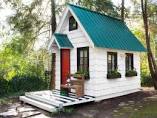
THE TINY HOUSE PHENOMENON
The tiny house social movement is about more than just living in a smaller home. There are environmental concerns, financial concerns, and the desire to live more free. Freedom from “stuff” or the minimalist lifestyle is not an easy one but many people are adopting this lifestyle to be free from clutter and financial obligations.
The average cost of a tiny house is $23,000 if built by the homeowner. Compare that cost to the average size home of $272,000 before 30 years of interest due on a loan. Seventy eight percent of tiny home owners have no mortgage compared to sixty five percent of home owners with traditional homes. According to www.nerdwallet.com eighty nine percent of tiny home owners have less credit card debt than the average American. Sixty five percent of them have zero credit card debt. For many Americans one third to one half of their income goes to provide a house. Two out of five tiny homeowners are over the age of 50 years old.
Tiny house living is not for everyone. The average size of a tiny home is 186 square feet. The standard US home is approximately 2,100 square feet. Tiny houses come in all different sizes, styles, and floor plans. Many have a loft as the bedroom. The lofts can be accessed by stairs or a ladder. The kitchens and bathrooms are very small with special fixtures to accommodate the tiny square footage. These houses are called “tiny” for a reason.
There are two types of tiny homes, a tiny house on wheels and a tiny house on a foundation. The house on wheels is legally considered a recreational vehicle, or RV. If you are planning to travel with your house this is the way to go. A tiny house owner on wheels does not have to deal with zoning or building codes. Simply find a place to park your home. Camping sites, RV parks, or a friend’s back yard are perfect places to park for a while. If you are planning to build your tiny house on wheels you would register it as an RV with the state. In most states the house will have to pass some safety inspection before you get a license plate. The other type of tiny house is on a foundation. This type of house is called an accessory dwelling unit, or ADU. Building an ADU can be more complicated. Each state has their own regulations concerning permanent tiny houses. You can find more information about the regulations at www.americantinyhouseassociation.org .
If you are living and traveling in a tiny house you will need a mail forwarding service. Call Texas Home Base toll free at 866 766-2095 for more information.
See 5 Tiny House Living Tips on our blog – click here
